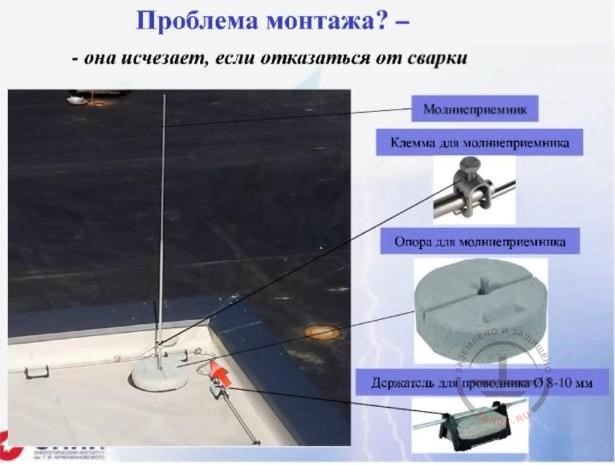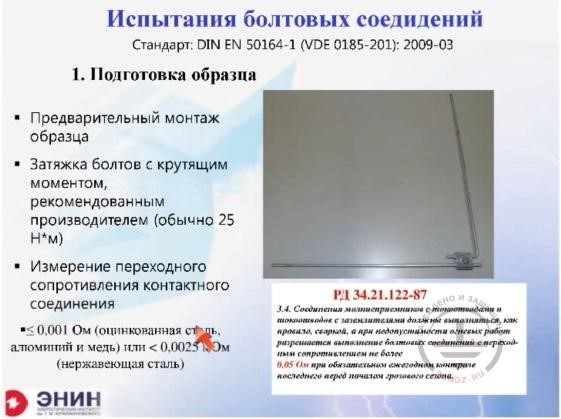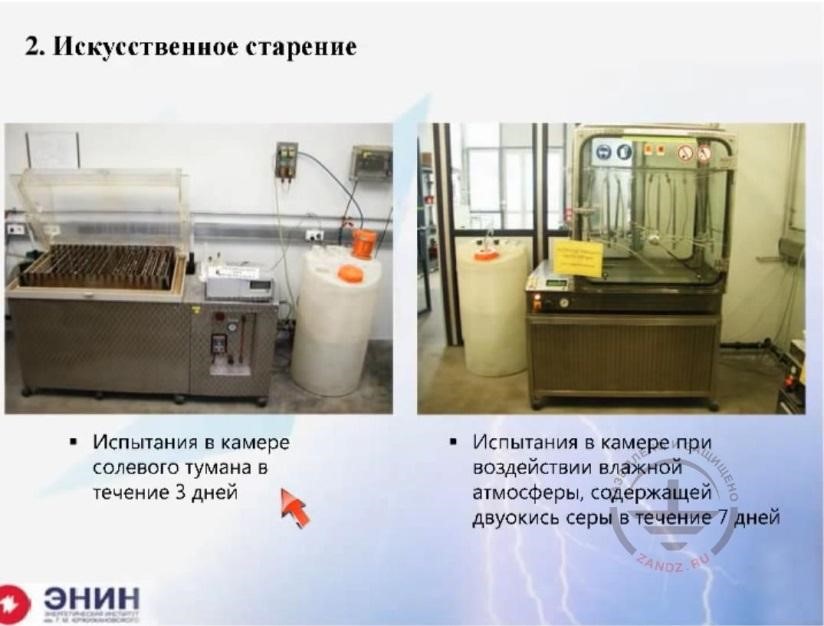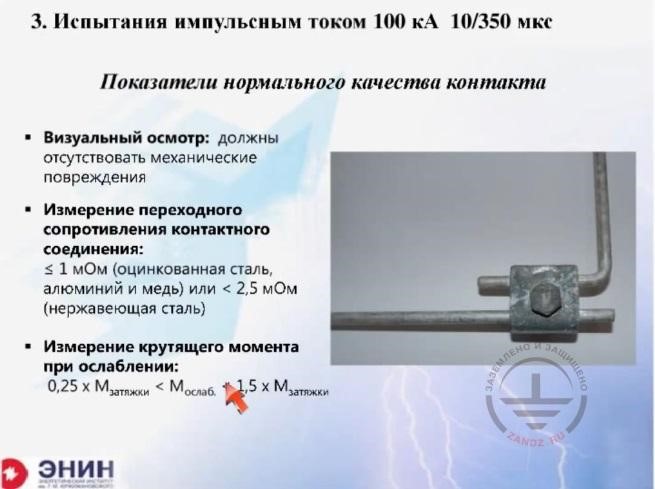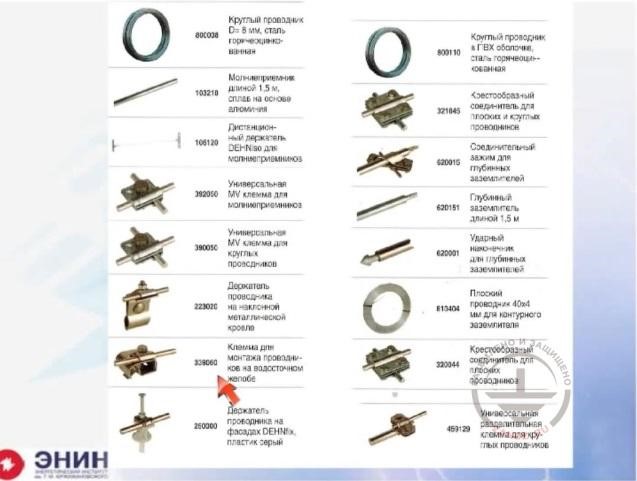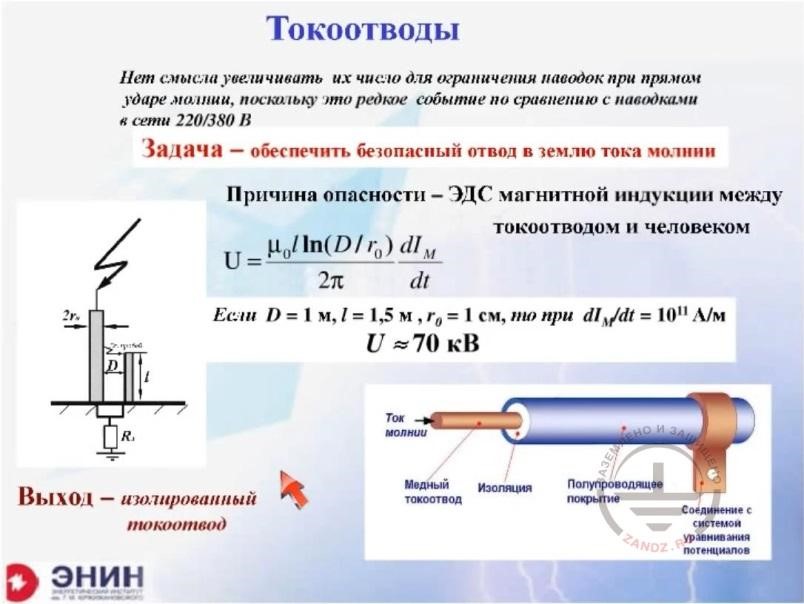The second webinar of Grounding and lightning protection: answering frequently asked design questions series.
Webinar text. Page 2.
Quick navigation through slides:
<< Page 1:
1. Private housing protection
2. RD 34.21.122-87 regulatory requirements
3. SO-153-34.21.122-2003 requirements
4. RD 34.21.122-87 minimum requirements
5. Expected number of direct lightning strikes
6. Influence of adjacent structures
7. Electromagnetic effects of lightning
8. Lightning proofing capacity of buildings
9. Typical urban development
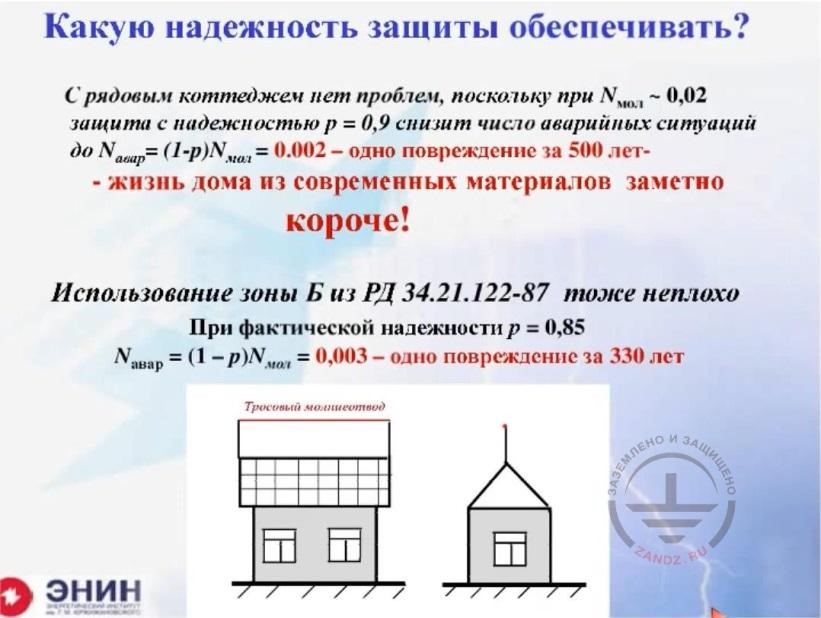
What protection reliability is to be provided?
| Какую надежность защиты обеспечивать? | What protection reliability should be provided? |
| С рядовым коттеджем нет проблем, поскольку при Nmol ~ 0.02 защита с надежностью p=0.9 снизит число аварийных ситуаций до Nавар=(1-p)Nмол =0.002 – одно повреждение за 500 лет – жизнь дома из современных материалов заметно короче! | There are no problems with an ordinary cottage, as with Nlight ~ 0.02 a protection reliability of p=0.9 will decrease the number of emergency situations to Nemer=(1-p)Nlight =0.002, i.e. one breakdown in 500 years. The service life of a house made of modern construction materials is much shorter! |
| Использование зоны Б из РД 34.21.122-87 тоже неплохо | Using B zone from RD 34.21.122-87 is also rather good |
| При фактической надежности p=0.85 | With an actual reliability of p=0.85 |
| Nавар =(1-p)Nмол=0.003 – одно повреждение за 330 лет | Nemer =(1-p)Nlight=0.003 meaning one breakdown in 330 years |
| Тросовый молниеотвод | Catenary wire |
If you don't want your roof to be punched by the lightning causing a fire in the attic. And now there is a question: what lightning protection should I install? What lightning rod reliability is necessary? This is a very difficult question, you know, because this depends on how much money the customer will pay you for the work you offer. What protection reliability is to be provided? What should you proceed from? I would start from the probable `number of lightning strikes, and this is 1 strike in 50 years. If I install a lightning rod capable of intercepting 90% of lightning strikes, i.e. the reliability is just 0.9, then what will I get in the end? Instead of one strike in 50 years, you'll get one dangerous strike in 500 years. One strike in 500 years - I think your client will agree to that scenario, keeping in mind that by installing the rod he or she will take care of his or her grandchildren and great-grandchildren, but then the Lord will probably take care of the next generations. Ensuring a protection reliability of 0.9 means installing a lightning rod or a catenary wire. I propose to take a catenary wire and strain it over the roof ridge. I believe that the elevation of the catenary wire above the roof of about 2 meters will provide a reliability of 0.9.
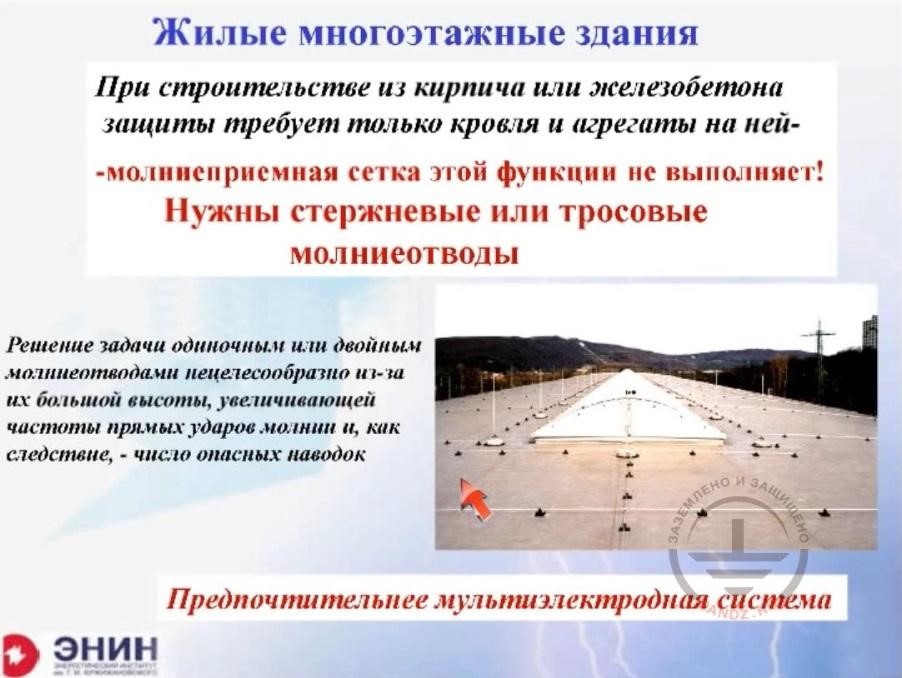
Residential high-rise buildings
| RU | EN |
| Жилые многоэтажные здания | Residential high-rise buildings |
| При строительстве из кирпича или железобетона защиты требует только кровля и агрегаты на ней | If bricks or reinforced concrete is used during construction, then only roofing and equipment installed on it require protection |
| - молниеприемная сетка этой функции не выполняет | - mesh cages do not perform the protection function |
| Нужны стержневые или тросовые молниеотводы | Lightning rods or catenary wires are needed. |
| Решение задачи одиночными или двойными молниеотводами нецелесообразно из-за их большой высоты, увеличивающей частоты прямых ударов молнии и, как следствие, число опасных наводок | Single or double lightning rods are not feasible in this case as they are too high, which increases the number of direct lightning strikes and, consequently, hazardous interferences. |
| Предпочтительнее мультиэлектродная система | Multi-electrode system is more preferable |
What if you are building a multi-storey building? If it is an office building or a shopping center? In this case, its roofing will be made of new synthetic or composite materials. And then you ask the customer whether the lightning strike into the roof and its damage is acceptable for him. The customer will flourish his arms and say this is unacceptable. And then you face (no sound) and you want to protect it against direct lightning strikes, even with a reliability of 0.9. And considering the roof is high, the lightning rods should be installed at a great elevation over it. And it is not customary today. Especially in Europe, where a high lightning rod is the least thing customers want. What do they think? They think "If I put a high lightning rod on the roof, then I effectively increase the height of the building. And if I increase the height, I will increase the probable number of strikes in my area, which means the increase of dangerous electromagnetic interferences. And I have an office building stuffed with microprocessor-based hardware and expensive office appliances. I do not want them to be damaged". So today, instead of one or two high lightning rods, clients prefer to arrange a series of small-height (2 to 3 meters) of air terminals sticking up like a pale fence on the roof, as it is shown in this picture taken in Germany. What problem arises in this case? Here's the problem. Russian standards prescribe that the installation of air terminals should usually be done by welding.
| RU | EN |
| Проблема монтажа? | Installation problem? |
| Она исчезает, если отказаться от сварки | It disappears if you elect not to use welding |
| Молниеприемник | Lightning rod |
| Клемма для молниеприемника | Lightning rod clamp |
| Опора для молниеприемника | Lightning rod support |
| Держатель для проводника Ø8-10 мм | Conductor holder Ø8-10 mm |
The fact is that RD 34 states that the installation of air terminals and down conductors is generally made by welding, but if welding works are not desirable, then it is allowed to use bolted joints with certain torque values. So the whole world is using this hint today. The whole world is moving away from welding, as a rule. And the whole world is carrying out installation works using bolted joints. Here I have to break my tradition, as I never make advertisements during my presentations. But today I will have to use data I trust. Not advertising booklets, but a serious research that has been held by a company to ensure the high quality of its products. And as a rule, I use the results of research I’ve participated in. In this case, this is a research by DEHN+SÖHNE, a company I have long been in contact with. Findings I will be showing today are extracts from my joint research with this firm, which has a Russian branch called DEHN RUS.
So that's what I'll start with. Nobody is mounting lightning rods by welding today. Slightly elevated lightning rods are mounted using the very same principle Christmas trees are usually installed in Russia — a cross-shaped stand. The difference is that not a cross-shaped stand, but concrete pigs are used. Lightning bars inserted in these pigs and fixed by bolts. And now I'll tell the most important thing. The most important thing is the quality of such connection.
| RU | EN |
| Испытания болтовых соединений | Bolted joint testing |
| Стандарт DIN | DIN EN 50164-1 (VDE 0185-201): 2009-03 |
| 1. Подготовка образца | 1. Preparing a sample |
| Затяжка болтов с крутящим моментом, рекомендованным производителем (обычно 25 Н*м) | Bolt tightening with a torque recommended by the manufacturer (usually, 25 N*m) |
| Измерение переходного сопротивления контактного соединения | Measuring the transition resistance of the contact |
| ≤0.001 Ом (оцинкованная сталь, алюминий и медь) или <0.0025 Ом (нержавеющая сталь) | ≤0.001 Ohm (galvanized steel, aluminium and copper) or <0.0025 Ohm (stainless steel) |
| РД 34.21.122-87 3.4. Соединения молниеприемников с токоотводами и токоотводов с заземлителями должны выполняться, как правило, сваркой, а при недопустимости огневых работ разрешается выполнение болтовых соединений с переходным сопротивлением не более 0.05 Ом при обязательном ежегодном контроле последнего перед началом грозового сезона |
RD 34.21.122-87 3.4. As a rule, the connections of lightning rods with down conductors and down conductors with ground electrode systems shall be carried out with welding. If hot works are not permitted, then bolted joints are permissible with a maximum transition resistance 0.05 Ohm provided that the annual inspection is carried out before the beginning of thunderstorm season. |
In Europe, a system has been developed that ensures a transition resistance of grounding at the level of 0. 001 Ohm, instead of 0.005th required by RD 34. And that connection is checked rather rigorously.
| RU | EN |
| 2. Искусственное старение | 2. Artificial Ageing |
|
|
|
|
First, the contact connection pickled in salt spray for 3 days, then they are immersed into atmospheric sulfur dioxide for a whole week, and after that, the connections are tested the following way.
| RU | EN |
| 3. Испытания импульсным током 100 кА 10/350 мкс | 3. Measurement by pulse current 100 kA 10/350 ms |
| Показатели нормативного качества контакта | Normative values of contact quality |
|
|
|
|
| ≤1 мОм (оцинкованная сталь, алюминий и медь) или <2.5 мОм (нержавеющая сталь) | ≤1 mOhm (galvanized steel, aluminum and copper) and <2.5 mOhm (stainless steel) |
|
|
| 0.25 х М затяжки <М ослаб. 1.5х Мзатяжки | 0.25 х M tightening <М weakening. 1.5х М tightening |
It is checked whether or not the contact resistance remains at the level of one milliohm (or 2.5 milliohms for stainless steel). It is also checked whether the bolting torque remains unchanged. If all these parameters remain unchanged, then the product is ready for sale. Such products can be easily bought from a number of Russian companies.
I've found an SKU list from one of the catalogs. This is DEHN +SÖHNE catalog. There's a lot of connection types for all occasions there. Competing firms are also ready to offer you a range of products, although probably not as wide as DEHN +SÖHNE can offer. In any case, the choice is very extensive. And then you can install lightning rods with a low elevation. But the question here is how can you calculate them? How many lightning rods will you need? What space between them should you provide? This work is specified neither in RD 34 nor in CO; it is not standardized in any way. What can I recommend you? The same thing again. ZANDZ.com project has a software product it is ready to offer to the broad technical community. Please contact ZANDZ.com and find out how you can use it. Everything is here.
| RU | EN |
| Токоотводы | Down conductors |
| Нет смысла увеличивать… | It is unreasonable to increase their number to limit interferences caused by the direct lightning strike, as it is a rare event compared to 220/380 V grid interferences |
| Задача – обеспечить… | The task is to ensure a safe lightning current drainage to the soil |
| Причина опасности – ЭДС… | The cause of danger is induction electromotive force between the current and a person |
| Если D=1 м… | If D=1m, l=1.5m, r0=1cm, then with dIm/dt=1011 A/m U≈70kV |
| Ток молнии | Lightning current |
| Медный токоотвод | Copper down conductor |
| Изоляция | Insulation |
| Полупроводящее покрытие | Semiconducting coating |
| Соединение с системой уравнивания потенциалов | Equipotential bonding system connection |
| Выход – изолированный токоотвод | The solution is an insulated down conductor |
Let's talk about down conductors in residential buildings. During our last seminar, I've said that increasing the number of down conductors a very effective method to limit electromagnetic interferences in the internal volume of the building. What I've told you was correct. But it is correct for long buildings. In this case, there are a lot of down conductors. And in your individual building, if its area is small, then there will be a very small number of down conductors there. Usually, there will be two, or maximum four down conductors. And generally speaking, splitting the current into four paths does not affect induced currents significantly. And actually, these are not induced currents you have to worry about. You have to worry about a different thing. And this is a possible contact between the down conductors and people. (Look, here is is the down conductor, and this stick is a man. A loop is formed here, and the lightning current going through the down conductor causes a rather strong induced current here). If for example the distance between the man and the down conductor is 1 meter, and the man touches the down conductor with his hand at the level of 1.5 m, then the induced current with a voltage of 70 kV appears here. Imagine a man who has touched such a down conductor at his residential area. This voltage probably won't kill him because it is short-acting, but the feeling will be very unpleasant. I know it myself. I've been subject to this kind of voltage in the laboratory. What should you do in this case? The easiest and most important step is not saving on down conductors. Today, insulated down conductors are available and their insulation withstands a voltage of at least 100 kV. And forward-looking companies, like the mentioned DEHN+SÖHN, make not just insulated down conductors, but also down conductors with a special semiconductor covering that increases dielectric strength significantly. And such down conductors are safe for people and for the equipment installed at your home. For example, a TV antenna or a satellite dish, which is desperately advertised on the TV by that nasty guy.
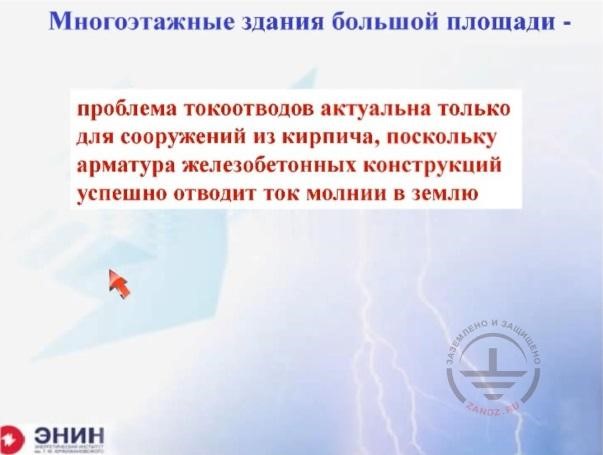
Large-area multi-storey buildings
| RU | EN |
| Многоэтажные здания большой площади | Large-area multi-story buildings |
| Проблема токоотводов актуальна только… | The down conductor problem is important only for brick buildings, as the concrete reinforcement bars drains the current to the soil successfully |
The problem of down conductors as I've highlighted it, generally relates only to individual buildings. If we talk about the mass construction of multi-storey residential buildings, their steel structures serve as down conductors in this case.
<< Previous Page
Slides from 1 to 10
Next Page >>
Slides from 19 to 26 + questions and answers session
Useful materials for designers:
- Webinars with the leading industry experts
- Everything for the calculation of grounding and lightning protection
- Useful materials: articles, recommendations, examples
Related Articles:
 Lightning protection of residential and public buildings - answers to frequently asked questions in the design
Lightning protection of residential and public buildings - answers to frequently asked questions in the design


 Lightning Protection of Large Territories: Parks, Grounds, Plant Territories. Page 1
Lightning Protection of Large Territories: Parks, Grounds, Plant Territories. Page 1
 Lightning Protection of Large Territories: Parks, Grounds, Plant Territories. Page 2
Lightning Protection of Large Territories: Parks, Grounds, Plant Territories. Page 2
 Lightning Protection of Large Territories: Parks, Grounds, Plant Territories. Page 3
Lightning Protection of Large Territories: Parks, Grounds, Plant Territories. Page 3


